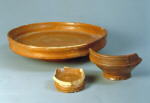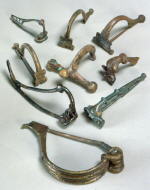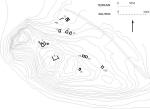Near the breakthrough of Danube through the last Carpathian foothills rises over its junction with the March River near Devín a stone cliff. Before the arrival of Romans, in the space bar of the so-called Hungarian gate, the crossroad of two important transmission communications – the Danube and the Amber road, was situated a Late Latène Period fortified settlement. Together with Braunsberg in Hainburg an der Donau and Bratislava they created a trinity of the oppidum centers of the Celtic Boii. This initially homogeneous Celtic territory situated at both watersides of Danube was in the fortieths years of the last century of the old era disturbed by the Dacian invasion, which indeed after the death of the Dacian ruler Burebistus lost its intensity. The rest of the Celtic population then apparently got under the sphere of influence of the Noric Kingdom.

 The
strategic position of the Devín cliff played an important role already during
the first Roman expansion to central Europe. The proofs of the oldest Roman
building activities on the stone elevation originate form the period of the
emperorship of Augustus. On the northern terrace of the so-called central castle,
powerful Latène Period layers from the second half of the 1st century
B.C. with relics of metallurgy and smithery, together with the documentations
of commercial activities, including coins and antique imported goods, were found.
The late Latène Period layers covered on this place by fire consumpted parts
of temporal dwellings with clay floors and wicker walls spreaded with clay,
in those exclusively Roman founds from the Late Augustinian Period have been
found. Within the founds prevailed the fine dine pottery, among which dominates
for the Middle Danube circumstances a unique collection of plates, glasses and
cups made of the North Italian terra sigillata with signatures of several manufacturers,
but also clay lamps and various types of mugs have been found. Besides pottery,
the finds involve also fibulas, fragments of military outfits, weapons, tools
and copper asses of the emperor Augustus.
The
strategic position of the Devín cliff played an important role already during
the first Roman expansion to central Europe. The proofs of the oldest Roman
building activities on the stone elevation originate form the period of the
emperorship of Augustus. On the northern terrace of the so-called central castle,
powerful Latène Period layers from the second half of the 1st century
B.C. with relics of metallurgy and smithery, together with the documentations
of commercial activities, including coins and antique imported goods, were found.
The late Latène Period layers covered on this place by fire consumpted parts
of temporal dwellings with clay floors and wicker walls spreaded with clay,
in those exclusively Roman founds from the Late Augustinian Period have been
found. Within the founds prevailed the fine dine pottery, among which dominates
for the Middle Danube circumstances a unique collection of plates, glasses and
cups made of the North Italian terra sigillata with signatures of several manufacturers,
but also clay lamps and various types of mugs have been found. Besides pottery,
the finds involve also fibulas, fragments of military outfits, weapons, tools
and copper asses of the emperor Augustus.  Two
horizons of clay floors of barracks from the Augustinian Period covered the
square ground plan of the construction made of huge dry laid blocks of untreated
quarry stone, which undoubtedly created the foundations of a multistoried wooden
tower. Though the constructions were strongly damaged, the stratigraphic situation
shows clearly, that the early Roman occupation of the Devin uphill was not a
short time event and approximately between the last decade of the old era and
the first two decenes A.D. repeated building activities have occurred here.
Two
horizons of clay floors of barracks from the Augustinian Period covered the
square ground plan of the construction made of huge dry laid blocks of untreated
quarry stone, which undoubtedly created the foundations of a multistoried wooden
tower. Though the constructions were strongly damaged, the stratigraphic situation
shows clearly, that the early Roman occupation of the Devin uphill was not a
short time event and approximately between the last decade of the old era and
the first two decenes A.D. repeated building activities have occurred here.
Two groups of finds are important for their interpretation. At the first place the militaria (flat, conical and three-edged arrowheads, belt and armor buckles, tent-peg), which are proofs of presence of a military component. According to the testimony of Veleius Paterculus, they are most likely directly connected with the expansion of Tiberius against the Markomanni king Marobudus in the year 6 A.D. Different subjects (casting-crucibles, bronze-ingots and semi finished goods, weights, balance scales, raw amber) bear ship to manufacturing and commercial activities. They are apparently proofs of the fact, that maybe already before the arrival of the military units, or jointly with them, came to this place also groups of negotiators, craftsmen and traders, who afterwards developed their proceedings here. Mentioned founds definitely confirmed the Roman presence northerly from Danube in the time of the occupation of Pannonia and formation of Imperial frontiers upon this flow.
Devín obviously played an important role also in the following period, when it, as a natural bridgehead, served for ensuring the Roman interests beyond Danube, whether as the central base for commercial routes, or military campaigns into Barbaricum. From the following centuries, direct proofs of the next Roman presence are missing, although it is less likely, that they would not use this strategic position in the foreland of Carnuntum in the times of the Marcomanni wars.
 Further
fragmentary preserved Roman architectures date back to the beginning of the
3rd century. Near the western castle gate, strongly damaged remains
of walls and a mortar floor of a square construction II of about 5,5 x 7,5 m,
with traces of vertical wooden postes in the corners have been uncovered. Its
floor covered a part of the quoin basement of an older construction from small
quarry stones. Next to it a conduit made of dry laid blocks of quarry stones,
roofed by stone plates and a fragment of foundations of an another building
were detected.
Further
fragmentary preserved Roman architectures date back to the beginning of the
3rd century. Near the western castle gate, strongly damaged remains
of walls and a mortar floor of a square construction II of about 5,5 x 7,5 m,
with traces of vertical wooden postes in the corners have been uncovered. Its
floor covered a part of the quoin basement of an older construction from small
quarry stones. Next to it a conduit made of dry laid blocks of quarry stones,
roofed by stone plates and a fragment of foundations of an another building
were detected.
Considerably better preserved remained the walls of the Roman architecture I., which was built on the northern terrace of the Devin uphill. Its basement stall, 45 cm thick, was built from quarry stones put together with limy mortar. Initially, it had apparently a square ground plan, latticed by screens to four, eventually even more space bars. Its core and the oldest building part with deeper basements is the southeast block with two rooms. From them bar A has a semicircular apse and in the northwest section a square, initially probably vaulted niche with block stone corners and extended foundations. In the second phase, further rooms C, D were built and in the northern corner, destroyed by a modern ditch, probably another space bar has been situated. Old mortar floor was not preserved; in the apse was the new floor covered by irregularly refracted stone plates. The proofs of warm-air heating have not been found. In the very surrounding, besides the gravel field modifications, no other Roman building remains have been recognized. In the fill and in the surrounding uncountable finds were found, that date back to more time periods. From the 2nd – 3rd century are the shards of the Panonnian pottery, a fragment of Middlegallic terra sigillata, a bricks with a stamp of the X. legion as well as XVIII. cohort of volunteers, quantum of smith slag and many nails from military shoes. According to the qualitative stall and little article finds it is possible, that it was built sometimes during the reign of the Severians in the early 3rd century. Further founds prove its rebuilding and using also in the 4th century (bricks with stamps from the group OFARN and other founds).
The function of this building remains unclear. Initially it might have served for military purposes. This could be indicated by its exposed position on the flat terrace of the Devín uphill with the view northwards. However its purpose could have changed in time, as it is signalized by the rebuilding marks.
Karol Pieta
LITERATURE
PLACHÁ, V./PIETA, K. 1986: Römerzeitliche Besiedlung von Bratislava-Devín. Archeologické Rozhledy 38, 339-357.
PIETA, K/ PLACHÁ, V. 1999: Die ersten Römer im nördlichen Mitteldonauraum im Lichte neuen Grabungen in Devín. In: Germanen beiderseits des spätantiken Limes. Spisy Arch. Ústavu AV ČR Brno 14, Köln-Brno, 179-205.